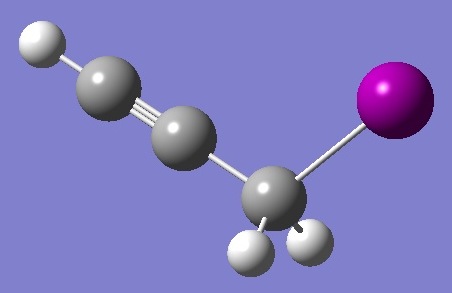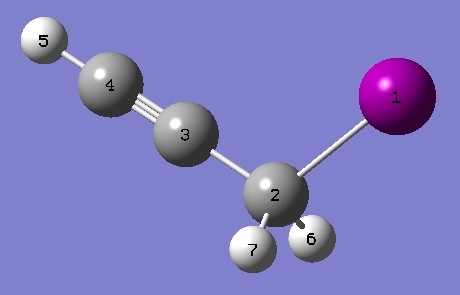|
|
|
|
|
|
|
|
|
|
|
|
|
|
|
|
|
|
|
|
|
HCC-CH2I |
|
|
|

|
|
|
|
|
|
|
|
|
|
|
|
|
|
|
|
|
|
|
|
|
|
|
|
|
|
|
|
|
|
|
|
|
|
|
|
|
|
|
|
|
|
|
|
|
Iodine |
|
|
|
Nuclear
Quadrupole Coupling Constants |
|
|
|
in 3-Iodopropyne |
|
|
|
|
|
|
|
|
|
|
|
|
|
|
|
|
|
|
|
|
|
|
|
127I nqcc's have been determined in 3-iodopropyne (propargyl iodide) by Ogata et al. [1], which authors also derived a partial ro structure. |
|
|
|
|
|
|
|
|
|
|
|
|
Calculation of the nqcc's was made here on this structure, and on an "re"
structure derived as discussed below. These are compared with the
experimental nqcc's in Tables 1 and 2. Structure parameters are
given in Table 3, rotational constants in Table 4. |
|
|
|
|
|
|
|
|
|
|
|
|
In Tables 1 and 2, subscripts a,b,c refer to the principal axes of the inertia
tensor; x,y,z to the principal axes of the nqcc tensor. The
nqcc y-axis is chosen coincident with the inertia c-axis, these are perpendicular
to the molecular symmetry plane. Ø (degrees) is the angle between its subscripted
parameters. ETA = (Xxx - Xyy)/Xzz. |
|
|
RMS is the root mean square difference
between calculated and experimental diagonal nqcc's (percentage of the
average of the magnitudes of the experimental nqcc's). RSD is the
calibration residual standard deviation for the B1LYP/6-311G(df,p) model
for calculation of the nqcc's. |
|
|
|
|
|
|
|
|
|
|
|
|
|
|
|
|
|
|
|
|
|
|
| |
|
|
|
|
|
|
|
|
|
Table 1. 127I nqcc's in HCC-CH2I (MHz). Calculation was made on (1) the ro [1] structure, and (2) the "re" structure. |
|
|
|
|
|
|
|
|
|
|
|
|
|
Calc (1)
|
|
Calc (2) |
|
Expt. [1] |
|
| |
|
|
|
|
|
|
|
|
|
Xaa |
- |
1229.4 |
- |
1254.8 |
- |
1250.25(79) |
|
|
Xbb |
|
195.2 |
|
247.7 |
|
234.98 |
|
|
Xcc |
|
1034.2 |
|
1007.0 |
|
1015.27 |
|
|
|Xab| |
|
1390.5 |
|
1306.6 |
|
1321.98(45) |
|
|
|
|
|
|
|
|
|
|
|
RMS |
|
28.1 (3.38 %) |
|
9.2 (1.10 %) |
|
|
|
|
RSD |
|
15.2 (1.23 %) |
|
15.2 (1.23 %) |
|
|
|
|
|
|
|
|
|
|
|
|
|
Xxx |
|
1045.2 |
|
1003.7 |
|
1008.65 |
|
|
Xyy |
|
1034.2 |
|
1007.0 |
|
1015.27 |
|
|
Xzz |
- |
2079.4 |
- |
2010.7 |
- |
2023.92 |
|
|
ETA |
- |
0.0053 |
|
0.0016 |
|
0.0033 |
|
|
Øz,a |
|
31.44 |
|
30.05 |
|
30.34 |
|
|
Øa,CI |
|
30.65 |
|
30.44 |
|
|
|
|
Øz,CI |
|
0.79 |
|
0.39 |
|
|
|
|
|
|
|
|
|
|
|
|
|
|
| |
|
|
|
|
|
|
|
|
|
|
|
|
|
|
|
|
|
|
|
|
| |
|
|
|
|
|
|
|
|
|
Table 2. 127I nqcc's in DCC-CH2I (MHz). Calculation was made on (1) the ro [1] structure, and (2) the "re" structure. |
|
|
|
|
|
|
|
|
|
|
|
|
|
Calc (1)
|
|
Calc (2) |
|
Expt. [1] |
|
| |
|
|
|
|
|
|
|
|
|
Xaa |
- |
1178.2 |
- |
1207.4 |
- |
1201.63(78) |
|
|
Xbb |
|
144.1 |
|
200.4 |
|
186.51 |
|
|
Xcc |
|
1034.2 |
|
1007.0 |
|
1015.12 |
|
|
|Xab| |
|
1415.5 |
|
1332.7 |
|
1349.29(28) |
|
|
|
|
|
|
|
|
|
|
|
RMS |
|
30.0 (3.75 %) |
|
9.9 (1.24 %) |
|
|
|
|
RSD |
|
15.2 (1.23 %) |
|
15.2 (1.23 %) |
|
|
|
|
|
|
|
|
|
|
|
|
|
|
|
|
|
|
|
|
|
|
|
|
|
|
|
|
|
|
|
|
|
|
|
The "re" structure given
in Table 2 was derived as follows: The structure was optimized at
the MP2 level of theory with aug-cc-pVTZ bases on C and H, and
6-311+G(d,p) basis on I. The CC, single and triple, bond lengths
were then corrected as discussed here. For CI, the equilibrium bond length for CH3I [2] is used. |
|
|
|
|
|
|
|
|
|
|
|
|
|
|
|
|
| Table 3. HCC-CH2I. Molecular structure parameters, partial ro [1] and "re" (Å and degrees). These structures are given here in Z-matrix format. |
| |
|
|
|
|
|
ro |
"re" |
|
|
|
|
 |
IC(2) |
2.149 |
2.1336 |
| C(2)H(6,7) |
1.096 (ass.) |
1.0853 |
| C(2)C(3) |
1.454 (ass.) |
1.4454 |
| C(3)C(4) |
1.206 (ass.) |
1.2044 |
| C(4)H |
1.056 (ass.) |
1.0614 |
| IC(2)C(3) |
111.8 |
112.54 |
| Click on |
C(2)C(3)C(4) |
180. (ass.) |
179.63 |
| image to enlarge. |
C(3)C(4)H |
180. (ass.) |
179.81 |
|
C(3)C(2)H(6,7) |
107.1 |
111.11 |
|
H(6)C(2)H(7) |
106.4 |
108.88 |
|
|
|
|
|
|
|
|
|
|
|
|
|
|
|
|
|
|
|
|
|
|
|
|
|
|
|
| Table 4. HCC-CH2I. Rotational constants (MHz). Normal species. |
| |
|
|
|
| |
|
"re" |
Expt. [1] |
|
|
|
|
|
A |
19 720.2 |
19 105.318(25) |
|
B |
1 745.5 |
1 737.7785(24) |
|
C |
1 619.7 |
1 607.6870(15) |
|
|
|
|
|
|
|
|
|
|
|
|
|
|
|
|
|
|
|
|
|
|
|
[1] T.Ogata and M.Kamitsuma, J.Mol.Struct. 352/353,345(1995). |
|
|
[2] J.Demaison, L.Margulès, and J.E.Boggs, Struct.Chem. 14,159(2003). |
|
|
|
|
|
|
|
|
|
|
|
|
|
|
|
|
|
|
|
|
|
|
HCC-CH2Cl |
HCC-CH2Br |
HCC-CH2CN |
CH3I |
|
|
|
|
|
|
|
|
|
|
|
|
|
|
|
|
|
|
|
|
|
|
Table of Contents |
|
|
|
|
|
Molecules/Iodine |
|
|
|
|
|
|
|
|
|
|
|
|
|
|
|
|
|
|
|
|
|
|
|
|
|
|
|
|
|
|
HCCCH2I.html |
|
|
|
|
|
|
Last
Modified 11 Dec 2008 |
|
|
|
|
|
|
|
|
|
|

